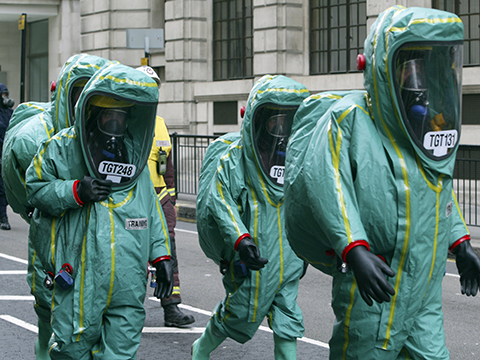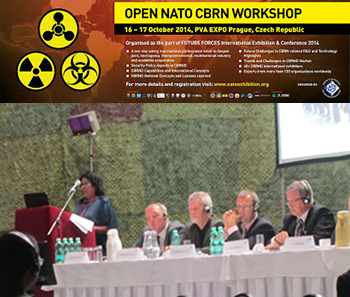ABOUT SIGZEEN INTEGRATED SOLUTIONS
Company
We are a Canadian company located in British Columbia, Canada. We are the first to innovate and develop the color-coded identification and visual communication system for first responders (law enforcement, fire, and rescue, medical and paramedics), other emergency responders (military, sheriff service, border service, CBRN personnel), and frontline healthcare workers (hospital and field healthcare workers).
This color-coded identification system helps to immediately identify and distinguish emergency responders and healthcare workers from other workers and the general public during mass casualty situations.
The Color-Coded Identification system is an integral part of our CBRNE Triangle Project, which we developed for integrated emergency response forces and frontline healthcare workers during mass casualty events. We specifically focused on chemical, biological attacks, and pandemic crises.
The chemical, biological, and pandemic crises are not new to governments, intelligent communities, and medical experts.
Since early 2008 we involved in researching, innovating, and developing concepts, equipment, programs and, systems related to critical concerns on CBRN (chemical, biological, radiological, nuclear, and explosive) events and pandemic crises. We initiated the CBRNE Triangle Project mainly by researching safety and security concerns for law enforcement during the Vancouver 2010 Winter Olympics, Canada.
These studies focused on finding solutions to protect law enforcement personnel during chemical and biological incidents, civil disobedience, riots, or similar situations during the Olympics. We recognized that distinguishing identification systems for first responders is a key to control any situation. As a result, we introduced the Color-Coded Checkered Identification system for law enforcement in British Columbia during the Olympics. It was well-received. Also, the Stanley Cup riots in 2011 highlighted the importance of the distinguishing identification system for first responders.
How We Started
Our mission started in 2008 by gathering information about biological infectious disease threats during the Vancouver 2010 Winter Olympics, " Olympic Security Assessing the Risk of Terrorism".
We assessed various scenario analyses and research conducted by world governments, integinence comminity, militery, international agencies such as NATO, the World Health Organization (WHO), and the private sector regarding CBRNE and pandemic events.
We specifically focused on the "Operation Dark Winter" exercise and evaluated the defense, medical, and other experts' relevant information. Also, various research conducted by governments and agencies reports including the U.S. National Strategy for Chemical, Biological, Radiological, Nuclear, and Explosive (CBRNE) Standards, and Canada CBRNE Strategy, and NATO Preparing first responders for CBRN incidents".
In addition, we also assessed Rand Corp. Objective Analysisi and Effective Solutions (2001). Are Local Health Responders Ready for Biological and Chemical Terrorism?
The U.S. Rand Corp report 2003 "Emergency Responders' view on their Protection Needs. "
The U.S. Rand Corp report 2002 "How Well-Integrated Are Local Public Health Departments and Hospitals With the Preparedness Activities of Other Emergency Responders?
We also gathered substancial amount of infomation during our development of the concept for next-generation future airpower and information superiority, for the deterrence (www.eqquera.com). This infomation provides us a complete understanding of the crisis of CBRN and pandemic events and the concequeances emergency responders, healthcare workeres and hospitals will face during crissis.
CBRNE Triangle Project
The project is designed to be developed in two phases:
First Phase: To build an effective interoperability workforce and safe work environment for first responders and other emergency responders. (2008 - 2020)
Second Phase: To build an interoperable workforce and work environment (hospitals and other facilities) for frontline healthcare workers. The final objective of the project is to integrate the two phases into a single Phase by 2025
From 2008 to 2021, we have carried out various programs and participated in numerous events nationally and internationally. These programs include a comprehensive research program on "Psychological behavior and social implications on humans without Electronic Communications and safety of first responders, healthcare workers, and the public".
NATO CBRN Workshop
In 2014, we addressed the nature of Cyber, EMP, and direct threats at the NATO CBRN Defence Conference held in Prague, Czech Republic. The topic was Cyber, EMP, and Physical attacks on power grids and telecommunications infrastructure, and the Color-Coded identification and visual communication system for first responders and other emergency responders.
These investigations revealed that chemical, biological, radiological, and nuclear defense and response to these events are complex since these events involve massive disruptions, mass casualties, and unprecedented health care catastrophes.
We also promoted our system to the federal and local governments, stakeholders, and emergency response communities. All have paid close attention to the Color-Coded Checkered design identification system we developed for first responders and other emergency responders.
View our mission
Project Milestone 2008 -2021
- Researched on how to protect first responders and other emergency responders in the event of a CBRN (Chemical, Biological, Radiological, Nuclear, and Explosive) incident and pandemic crisis.
2008
2009
- The Color-Coded IVC system introduced nationwide for first responders and other emergency responders.
- Launched the "Safety Awareness Program" and introduced the Color-Coded IVC system to federal, provincial, territorial, municipal, and local governments and relevant agencies.
- The Color-Coded IVC System introduced to first responder's communities in Canada and the U.S.
- The Color-Coded IVC System awareness program was carried out among first responders and other emergency response groups. .
- Launched a comprehensive research program - "Psychological behavior and social implications on humans without Electronic Communications, and safety of first responders and the public".
- Launched a full-scale implementation plan for the Color-Coded IVC system. The objective was to introduce the Color-Coded IVC system to the CBRNE Security Strategy Plan 2020. (U.S. and Canada).
2019-2020
- Organize a CBRNE EXCERCISE 2020 event in Vancouver, B.C. Canada. (Postponed until summer 2022 due to Covid -19 outbreak).

